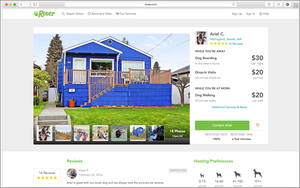 Rover.com,
founded as a startup weekend project, is a network of dog boarders, sitters and walkers. The service works like a business listing marketplace, but has a
strict vetting process to join the group. In fact, only 15% of people who apply make it into the marketplace after going through the strict vetting process, explains Brent Turner, COO at Rover.
Rover.com,
founded as a startup weekend project, is a network of dog boarders, sitters and walkers. The service works like a business listing marketplace, but has a
strict vetting process to join the group. In fact, only 15% of people who apply make it into the marketplace after going through the strict vetting process, explains Brent Turner, COO at Rover.
Still, the marketplace supports more than 65,000 sitters and dog walkers in its marketplace -- up 50% year-over-year -- across more than 10,000 in the United States.
Just two years ago,
less than 5% of Rover.com's site traffic from AdWords came from searches on mobile phones, and now it's over half. As the team realized how rapidly the traffic was shifting to mobile devices,
Google was there to guide them on taking advantage of mobile specific ads, bids and landing pages. In 2017, the company will look to expand internationally.
"In the beginning Google helps us
out by writing a few thousand versions of mobile-specific ad copy," he said. "We put those in the ad rotation, which helped us learn thematically from the way Google approached writing ad copy.
'Search for a dog sitter' from a mobile phone was one theme."
Turner, who served as GM of search and display for the Microsoft Media Network and EVP of call products at Marchex, said the
company began using AdWords from the beginning. The company was founded in 2012.
"Even if the search traffic doesn't pencil out in the early days, it does help you understand where the
problems are in the purchase flow when it comes to converting site visitors to customers," he said.
Indeed, for Rover.com the Google traffic, SEO and paid search served as a "roadmap" to
determine where people got stuck in the purchase process. From there the startup worked out the kinks to develop a positive return on investment to scale up the amount spent on campaigns.
Initially, the site did not work efficiently, but as more sitters joined the marketplace each individual figured out how to optimize their business listing on the site. Maps are included, with
sections for special needs. The site also includes sitters who are willing to watch pets on holidays. Rover.com optimizes the site as a whole for all of these requests, and each sitter learns how to
focus and optimize their listing to attract a specific customer segment, similar to a retail store.
Search terms used to attract searchers include "doggy day care," "dog boarding," "drop in
sitting" and all its variants.
Turner says that Rover.com needs to understand what type of optimization sitters in the marketplace do, so the two don't make changes that cancel out each other.
"The ability to bid on search traffic, bring it to the site and convert visitors to customers is essential," he said.
In addition to Google AdWords, Rover.com uses other traditional services
such as Google Analytics, but it also relies on Google Trends to monitor the growth of dog walker site category, which Turner believes remains in its infancy. It also helps Rover predict when
spikes in certain searches, so the company can meet customer demand.